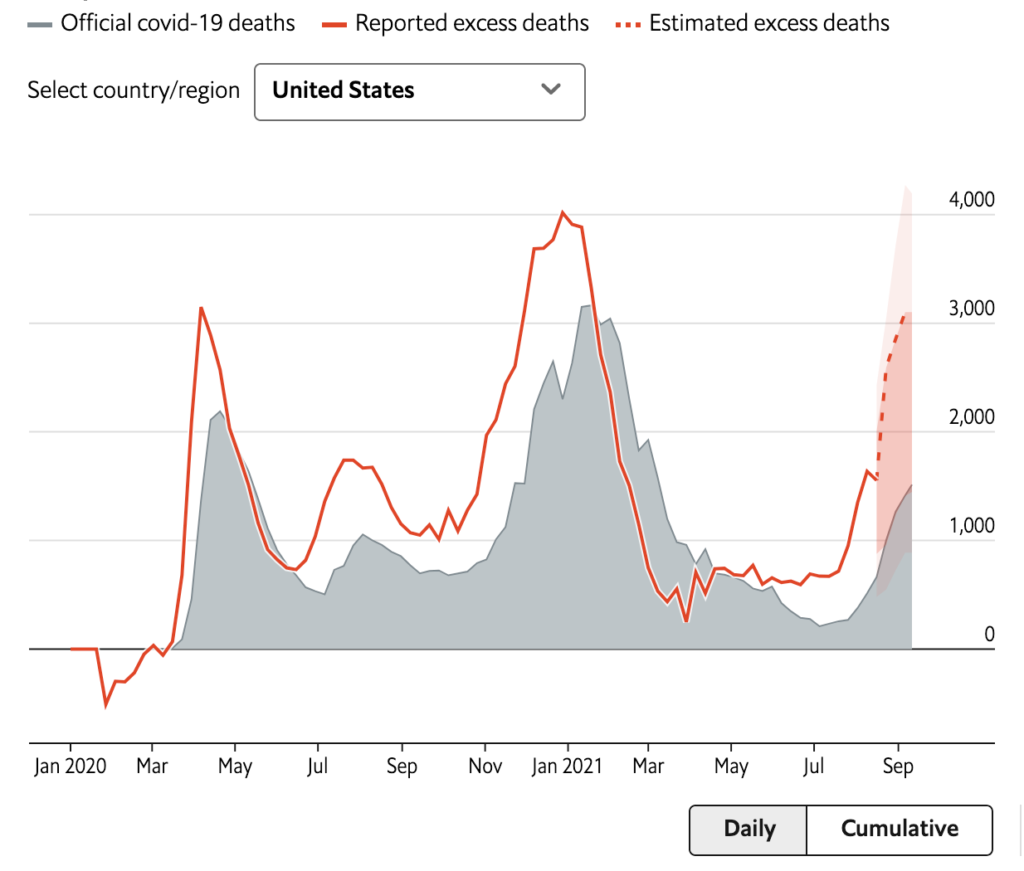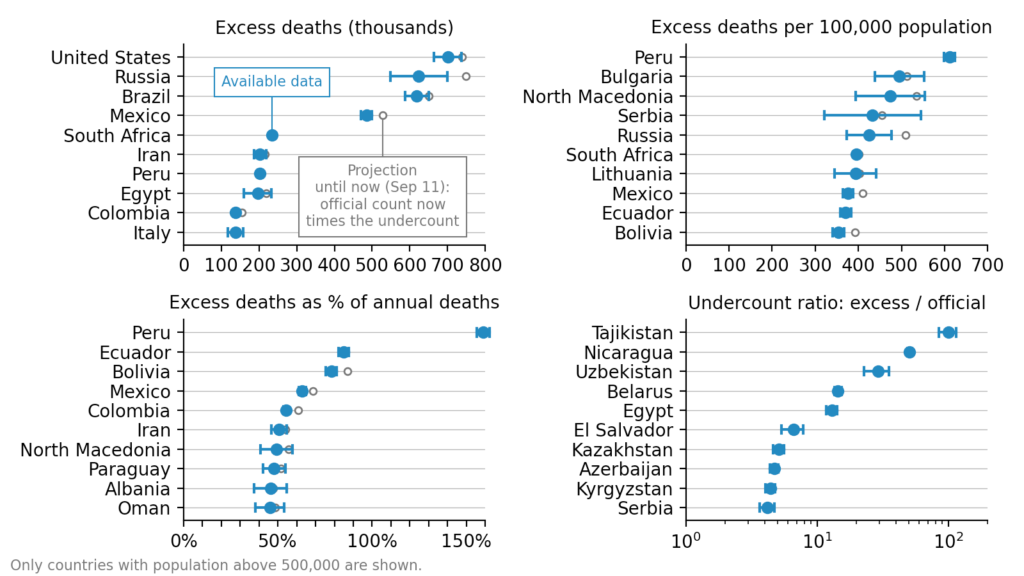A: Sadly, we are most likely UNDER-COUNTING Covid-19 deaths.
While the official global death toll from Covid-19 is now 4.6 million, the actual toll is estimated to be close to 15.4 MILLION people.
Among the most persistent COVID-19 myths is the idea that COVID-19 deaths are being over-counted, including stories of victims of motorcycle accidents getting tested in the hospital so they can be counted as COVID-19 deaths, or the infamous line that people are dying *with* COVID-19 rather than *of* COVID-19.
While there are almost certainly deaths that have been miscoded and COVID-19 deaths among people who would have died soon anyway, demographers have a way of getting around this messiness in assessing the real death toll of big mortality “shocks” to a population like natural disasters or pandemics.
➡️ We call this “EXCESS MORTALITY.”
As the name suggest, excess mortality tallies the number of deaths ABOVE & BEYOND those that would have been expected based on previous years. The benefit of this measure is that it does not rely on how COVID-19 deaths are coded—it counts deaths from ANY CAUSE- which most developed countries are pretty good at accurately counting (so they don’t have to pay out that social security/pension forever!).
While there are some slightly more complicated ways to do this, in essence “excess mortality” uses the average number of deaths in previous years as the baseline for “expected” deaths. So, this baseline already includes all the deaths that would “normally” occur due to heart attacks, strokes, accidents, etc., These baseline deaths are the counterfactual—meaning what would deaths in a country have looked like in the last year and a half in a bizarro world *without* COVID-19?
How many MORE deaths overall have we seen since the pandemic started compared to the average previous years? In many countries, these excess deaths substantially exceed official numbers of Covid-19 deaths.
➡️ In the US, current estimates are around 800,000-870,000 excess deaths—this is 30% HIGHER than the official COVID-19 death count, and 24% more deaths than would have been expected over this period of time. Let that number sink in.

➡️ In the UK, excess deaths are estimated at 120,000, almost 20% higher than the average deaths in previous years.
Other extremely hard-hit countries include:
➡️ Peru: 200K excess deaths; 159% higher than normal
➡️ Mexico: 480K excess deaths; 63% higher than normal.
➡️ Brazil: 620K excess deaths; 45% higher than normal.
➡️ South Africa: 230K excess deaths; 45% higher than normal.

Sadly, for countries without reliable death registration, it is much harder to be confident even in estimates of total or excess mortality. India is one example. With over 400,000 confirmed deaths, current estimates of excess deaths are over 4 million. These estimates are less reliable and have been extrapolated from local level data or survey data where people report on the deaths of family members. The real toll here may be even higher.
➡️ One challenge in using excess mortality is that it captures both “direct” and “indirect” deaths due to the pandemic.
“Direct” deaths are those caused by the virus but that might not have been counted as such, especially early in the pandemic when testing was less frequent. People who died at home or in nursing homes from the virus and were never tested would contribute to these numbers.
“Indirect” deaths can occur from other causes when hospitals are overwhelmed and/or patients delay seeking care. Indirect deaths would also include more deaths due to the social or economic distress of the pandemic.
Some excess deaths are counterbalanced by lives that are SAVED compared to a normal year. For example, due to lockdown and other prevention measures, deaths from flu and other infectious diseases dropped dramatically. There were also deaths averted from automobile accidents and air pollution due to less driving during lockdowns.
We can see these effects in countries that had lockdowns or social distancing but managed to stave off the virus itself (for example Finland, Iceland, Norway, Australia, South Korea) –they have had several thousand FEWER deaths than expected compared to previous years (We actually call this NEGATIVE excess mortality).
❓How do we know how many excess deaths were direct or indirect? It’s difficult to know for sure, but most excess mortality tracks closely the path of the virus across time and space in most countries. This correspondence of excess mortality with the path of the virus suggests many of the excess deaths are due to the virus itself AND indirect deaths due to overstretched health care capacity. Demographers will be sorting through the more detailed cause of death and hospital data for years to sort this out further.
So far suicide rates do not appear to have risen (and may have decreased in some places), but the US has seen an increase in drug-related mortality especially among younger adults, which we covered in a previous post.
We should also remember that the longer term health and mental health effects of the stress of the pandemic will continue play out over many years, so they are not fully accounted for here.
Two researchers Ariel Karlinsky and Dmitry Koba have created an amazing open access resource collecting and analyzing excess mortality data for over a hundred countries.—the World Mortality Dataset—a true public service during this pandemic. Read more about it here.
⬇️ BOTTOM LINE:
💥 Excess deaths account for the fact that some people who died of COVID-19 would have died anyway, and only counts what is above and beyond what is expected.
💥 Excess deaths were seen in all countries hard hit by the pandemic, but not in countries that have not (South Korea, Norway, Finland, Australia). In most countries excess deaths have been HIGHER, not LOWER than official COVID-19 deaths.
Love,
Nerdy Girl Jenn
Further reading:
Excess Death Tracker, the Economist:
Tracking covid-19 excess deaths across countries
The pandemic’s true death toll
Excess mortality dashboard in the US from CDC
Our World in Data Excess Mortality Explorer
UK Office for National Statistics Weekly Mortality Data


